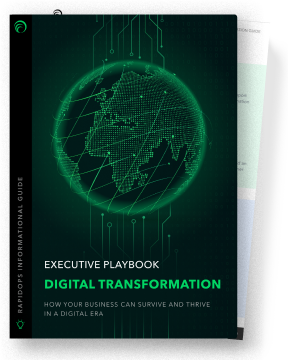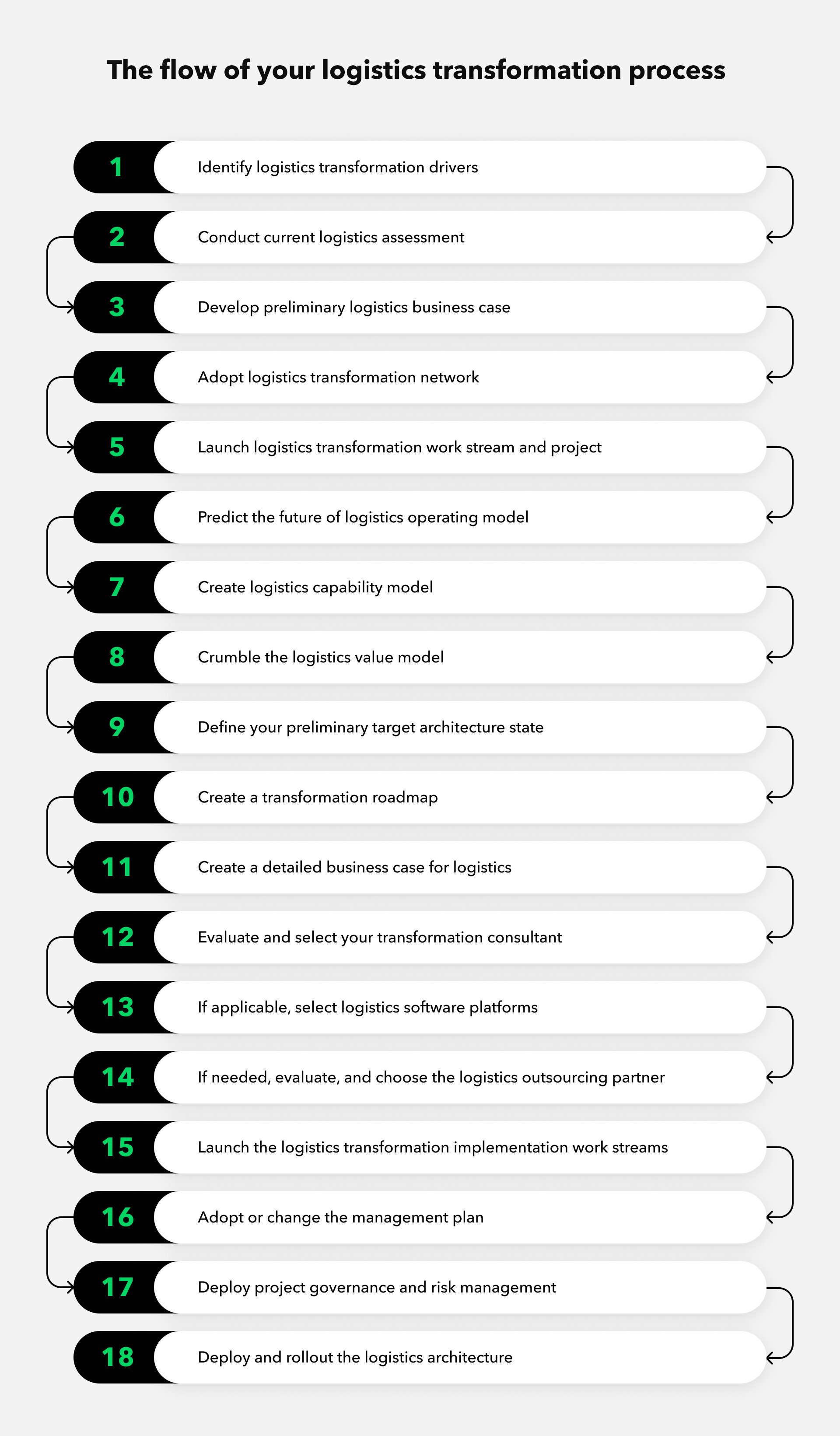In an era where speed is synonymous with success, distributors are finding themselves at a pivotal juncture. The explosion of e-commerce, fueled by shifting consumer behaviors and technological advancements, has not only accelerated the pace of commerce but also significantly raised customer expectations.
Today, customers demand not just faster deliveries but a transparent, flexible, and seamless purchasing experience. This new reality presents a dual challenge for distributors: to adapt swiftly to meet these expectations while maintaining efficiency and competitiveness.
As we venture deeper into this digital era, the message for distributors is clear: Embrace change, leverage technology, and place the customer at the center of your universe. To understand how digital transformation can revolutionize your logistics operations, visit our supply chain and logistics industry page.
The race is on, and speed, coupled with strategic digital transformation, will determine the winners. But what does digital transformation in logistics truly entail? At its core, it's about integrating digital technology into all areas of the logistics process, fundamentally changing how operations are conducted and how value is delivered to customers.
Digital transformation in logistics is not merely an upgrade of existing systems or logistics processes but a holistic reimagining of operations, strategies, and infrastructure to harness the power of digital advancements. From leveraging artificial intelligence for predictive analytics to employing the Internet of Things (IoT) for enhanced tracking and visibility.
This process promises to reshape the logistics sector by:
Integrating Digital Technologies
Implementing advanced digital solutions such as IoT for real-time tracking, AI and machine learning for predictive analytics, automated robotics in warehouses, and blockchain for secure, transparent transactions.
Cultural Shift
Encouraging a mindset shift within organizations to embrace experimentation, innovation, and a readiness to learn from failures, moving away from traditional, rigid operational models.
Operational Efficiency
Streamlining processes through automation and data analytics, leading to significant cost reductions, faster turnaround times, and enhanced productivity.
Customer Service Excellence
Providing unparalleled customer experiences through improved accuracy, transparency, and flexibility in delivery options, thanks to real-time data and analytics.
Competitive Advantage
Offering a platform for businesses to not just meet but exceed customer expectations, setting new standards in efficiency and responsiveness in the logistics industry.
Digital transformation in logistics is a strategic necessity in today’s fast-paced market, ensuring businesses are not merely surviving but thriving. By leveraging digital technologies, logistics companies can unlock new levels of efficiency, customer satisfaction, and agility, positioning themselves as leaders in the digital era.
The Imperative for Digital Transformation in Logistics
Global Trends and Customer Expectations
The digitization of commerce and the rise of e-commerce giants have escalated customer expectations, not just in terms of delivery speed but also visibility and reliability. Customers now demand real-time tracking, seamless delivery experiences, and flexibility in delivery options—capabilities that are only possible through digital transformation.
Competitive Landscape
The entry of tech-driven startups into the logistics space has disrupted traditional models of operation. These new entrants, leveraging digital platforms, AI, and analytics, are redefining what it means to be efficient. For established players, the message is clear: innovate or risk obsolescence.
Building Resilience
The COVID-19 pandemic underscored the fragility of global supply chains. Digital transformation equips businesses with the tools to build more resilient supply chains capable of withstanding shocks and disruptions. Technologies like AI for scenario planning and cloud computing for data accessibility ensure operations can quickly adapt and recover.

Assessing Your Digital Maturity
Understanding your organization’s current state of digital adoption is crucial for navigating the path toward digital transformation. Assessing digital maturity not only highlights where your business currently stands but also illuminates the path forward. Here’s how you can approach this critical evaluation:
1. Understanding Where Your Business Stands in Terms of Digital Adoption
The journey begins with a comprehensive audit of your existing technologies, processes, and digital capabilities. This evaluation should cover various aspects of your operations, from warehouse management and transportation to customer service and supply chain visibility. Key questions to consider include:
- What digital tools and platforms are currently in use, and how effectively are they being leveraged?
- How digitally literate is your workforce, and what training programs are in place to enhance their skills?
- To what extent are digital solutions integrated into your core logistics operations?
2. Tools and Frameworks for Assessing Digital Maturity in the Logistics Sector
Several models and frameworks can help businesses systematically assess their digital maturity. These tools often categorize maturity levels from basic digital capabilities to fully integrated, advanced digital ecosystems. For example:
The Digital Maturity Model (DMM)
This tool assesses digital maturity across dimensions such as strategy, culture, customer experience, operations, and technology.
Gartner’s Digital Business Maturity Model
It offers a framework for evaluating how well an organization is utilizing digital technologies to change business models and provide new revenue and value-producing opportunities.
Utilizing such frameworks provides a structured approach to evaluating your digital maturity, offering a clear benchmark against industry standards.
3. Identifying Gaps and Opportunities for Digital Enhancement
With a clear understanding of your current digital maturity, the next step is to identify the gaps in your digital landscape. This involves pinpointing areas where digital technologies could introduce efficiencies, enhance customer experiences, or create competitive advantages. Consider the following:
- Are there manual processes that could be automated to save time and reduce errors?
- Is there a need for unified systems where you can track all shipment-related information for better access and control?
- Could data analytics improve your forecasting, inventory management, or customer service?
- Are there opportunities to use IoT devices for better asset tracking and supply chain visibility?
In identifying these gaps, it's equally important to recognize opportunities for digital enhancement. This could mean adopting new technologies, improving data integration across systems, or upskilling your workforce to better leverage digital tools.
Finding opportunities with a technical expert could be a great step in navigating the complexities of digital transformation.
Key Technologies Driving Digital Transformation in Logistics
The logistics sector is undergoing a seismic shift thanks to a wave of advanced technologies that promise to revolutionize everything from warehouse operations to customer interactions. Here’s an overview of the pivotal technologies reshaping the logistics landscape.
1. Artificial Intelligence (AI) and Machine Learning (ML)
Use Cases:
Predictive Analytics: AI algorithms can analyze historical data to predict future inventory needs, helping businesses optimize stock levels and reduce carrying costs.
Natural Language Processing (NLP) for Customer Service: AI-powered chatbots can handle customer inquiries, track packages, and provide updates, ensuring a seamless customer experience.
Route Optimization: ML models can analyze traffic patterns, weather conditions, and delivery schedules to recommend the most efficient routes, reducing fuel costs and delivery times.
2. Internet of Things (IoT)
Use Cases:
Real-Time Asset Tracking: IoT sensors placed on vehicles and packages provide real-time location tracking, enhancing visibility throughout the supply chain.
Warehouse Management: IoT devices can monitor inventory levels, environmental conditions, and equipment status, automating restocking processes and maintenance schedules.
3. Blockchain Technology
Use Cases:
Supply Chain Transparency: Blockchain can create a tamper-proof, decentralized ledger of transactions, offering unparalleled transparency in the supply chain.
Smart Contracts: These self-executing contracts with the terms directly written into code can automate payments and orders based on predefined conditions, streamlining operations and reducing discrepancies.
4. Cloud Computing
Use Cases:
Scalability and Flexibility: Cloud-based logistics platforms allow businesses to scale their operations up or down based on demand, improving agility and reducing IT overhead.
Collaboration and Integration: Cloud platforms facilitate seamless data sharing and integration across supply chain partners, enhancing coordination and efficiency.
5. Robotic Process Automation (RPA)
Use Cases:
Automated Data Entry and Processing: RPA can handle repetitive tasks such as invoice processing and data entry, freeing up human resources for more strategic work.
Order Management: Robots can automate the picking and packing process in warehouses, improving accuracy and efficiency.
6. Data Analytics
Use Cases:
Customer Insights: Analytics tools can sift through customer data to identify trends and preferences, enabling more targeted service offerings.
Operational Efficiency: Data analytics can identify bottlenecks and inefficiencies in logistics operations, offering insights for continuous improvement.
7. 5G Connectivity
Use Cases:
Enhanced Real-time Communication: The rollout of 5G offers unprecedented speeds and connectivity, facilitating real-time data exchange across the logistics chain. This can significantly improve coordination between different components of the supply chain, from warehousing to last-mile delivery.
IoT Device Integration: 5G's low latency and high capacity enable the seamless integration of thousands of IoT devices in logistics operations, from tracking devices on containers to sensors in warehouses, enhancing visibility and operational efficiency.
Crafting an effective strategy for logistics digital transformation
The three easy steps towards value chain optimization for business logistics:
1. Planning an effective logistics transformation
Keep the organizational digital vision as your starting point. Define the digital vision in line with other business leaders in your organization. Decide upon the type of digital experience you want to deliver to your customers and align it with the identified value chain opportunities to deliver it.
The CEO's priority is a critical juncture at this point, as highlighted by Gartner in their 2022 survey of 460 CEOs. The survey highlights that the business leader's sole focus is on business growth, yet they are willing to operate with new operating models and corporate structures.
Once your company sets out a digital vision for its supply chain, it should articulate that idea in terms of business and technological capabilities.
These might include the following points:
- Better decision-making with Machine learning capabilities.
- Automated S&OP preparation and workflow management with process automation.
- Live notification for end-to-end customer engagement throughout the process.
- Business innovation model for logistics automation process and seamless ERP integration.
- Talent requirements for digital applications enablement and implementation.
Setting performance measures completes the company's vision for logistics transformation. It requires the company to measure its current performance, identify weak areas, and set achievable improvement goals.
2. Aligning the logistics operating model with your digital vision
Around 25% of logistics businesses are aligned with a singular governance process. The lack of alignment clarity creates a dearth of opportunities for logistics to support any retail or manufacturing business's key digital vision.
The company must align the logistics operating model with the digital vision.
For instance, a product manufacturer's business priority is to make sure that their customer's equipment never runs into problems or remotely detects and troubleshoots the same for a better customer experience.
With modern digital advances, this has become a reality, where the product manufacturer can digitally monitor the assets and provide real-time solutions. Such a service enables manufacturers to improve their service-based revenue streams.
If we talk about the real-world application of this instance, then HP's Instant Ink suits the category perfectly, where the manufacturer ensures the printers always stay online with a subscription-based model for ink or toner, hassle-free delivery, and prepaid recycling.
To deliver such digital business priorities, you need a digitized supply chain! Digitizing the supply chain means more than simply responding to spare parts orders.
It includes predicting potential failures, maintaining seamless spare parts supply, and providing service across the partner geological ecosystem to prevent unnecessary downtime.
3. Prioritizing your technology investments
The recent pandemic has shown the business world that the digitalization of logistics processes is a step toward a safer future driven by automation, predictability, and survival.
Logistics businesses must focus on operational improvements to boost their bottom line and create enough revenue to secure investment opportunities in future top-line technologies.
Business leaders need to modify their conventional and conservative approach to match the requirements of modern, wider organizational goals and priorities.
They need to reshape future-proof digital logistics that deliver more than just products but also an excellent customer experience.
Creating a digital transformation roadmap for next-gen logistics
Here is an illustrative guide to help you understand the logistics digital transformation journey you need to start.

Strategy - Create a process roadmap that will guide your strategy execution
Preparation - Streamline and unify your logistics data
Analytical Approach - Create a data pool with powerful analytics
Development - Hire a digital transformation partner based on your digitalization goals
Collaborate - Collaborate with your teams to carry out a successful logistics transformation

The logistics transformation process is necessary for aligning logistics with your overarching business goals to achieve maximum efficiency. It redefines the responsibilities within your organization. This change cannot take place overnight and must be done in a step-by-step, strategic approach.
Measuring Success and Continuous Improvement
Setting KPIs and Metrics to Track the Success of Digital Transformation Initiatives
Implementation
Identify Relevant KPIs
Essential KPIs might include metrics related to operational efficiency (e.g., order fulfillment times, inventory turnover rates), customer satisfaction (e.g., NPS scores, delivery accuracy), and financial performance (e.g., cost reductions and revenue growth).
Benchmarking
Establish baseline measurements for each KPI before implementing digital transformation initiatives. This provides a clear point of comparison to measure the impact of these initiatives over time.
Regular Review and Adjustment
Continuously monitor these KPIs, comparing actual performance against targets. Use these insights to refine strategies and initiatives, ensuring they remain aligned with business goals and customer needs.
Strategy
Data-Driven Decision-Making
Data analytics can be used to gain real-time insights into operations, customer behavior, and market trends. This empowers logistics companies to make informed decisions, optimize processes, and adapt strategies proactively in response to market dynamics.
Continuous Improvement
Adopt a culture of continuous improvement, using analytics to identify areas for enhancement. Encourage experimentation and innovation, using data insights to guide the development of new solutions and improvements.
To conclude: Your value chain digitization must align with your strategy
The companies realize the potential benefits of using modern technologies, but they are still struggling to take the right approach toward transformation & implementation.
When businesses develop a comprehensive roadmap for opportunities, they can bring flexibility and resilience to their logistics while improving processes and lowering additional transport costs.
By carrying out a thorough analysis of existing processes and drawing up a long-term transformation roadmap, the companies can better capture the actual value that digital technology can provide.
Rapidops, Inc. specializes in providing digital transformation services tailored to the logistics industry. With over 16 years of experience, we've empowered numerous logistics businesses to navigate their transformation journey with confidence.
Our team of experts is dedicated to identifying opportunities and delivering effective solutions for enhanced efficiency and growth. Book your cost-free consultation call with us today to explore how we can optimize your digital landscape and drive your logistics business forward.

Saptarshi Das
Content Editor
9+ years of expertise in content marketing, SEO, and SERP research. Creates informative, engaging content to achieve marketing goals. Empathetic approach and deep understanding of target audience needs. Expert in SEO optimization for maximum visibility. Your ideal content marketing strategist.
What’s Inside
- The Imperative for Digital Transformation in Logistics
- Assessing Your Digital Maturity
- Key Technologies Driving Digital Transformation in Logistics
- Crafting an effective strategy for logistics digital transformation
- Creating a digital transformation roadmap for next-gen logistics
- Measuring Success and Continuous Improvement
- To conclude: Your value chain digitization must align with your strategy

Let’s build the next big thing!
Share your ideas and vision with us to explore your digital opportunities

Receive articles like this in your mailbox
Sign up to get weekly insights & inspiration in your inbox.
